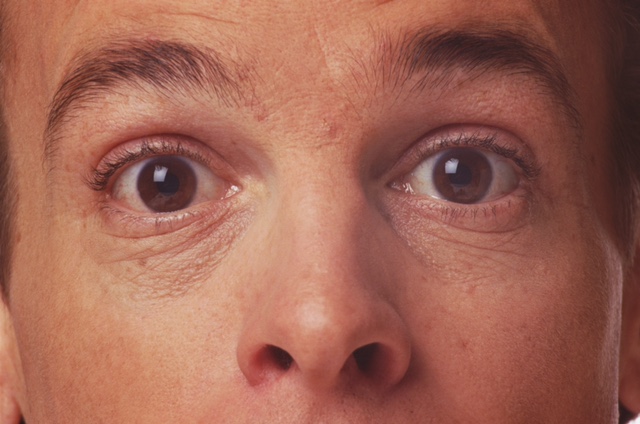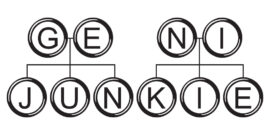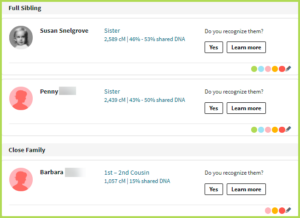In my earlier posts I walked you through some considerations for which on-line provider you might choose in order to build your family tree. I also touched on other sources of genealogical data you might access both on-line and off. And now you might be considering doing a DNA test to help build your family tree. It definitely would help with that! But before you commit to doing that DNA test, it’s important for you to know the many pros and some pretty critical cons.
The ABC’s of DNA Tests

So let’s talk DNA… Very simplistically, everybody has 23 pairs of chromosomes which carry your genes. One set of 23 came from your mother, and the other set of 23 came from your father. Joined together as 23 pairs, these genes are the “recipe” that make you, you.
The test maps all the locations across all your chromosomes, then compares your “map” to all the people in the testing company’s database. You will receive a list of the people that match you exactly in the same location of any of your “spots”. The length of the string of matching DNA is measured in “centimorgans”. To be an ancestral match, the DNA string must be at least 6 centimorgans long.
This DNA has been passed down to you from generation after generation of your ancestors. If you have an exact match to someone else on even one piece of your DNA that is longer than 6 centimorgans, you two likely have a common ancestor. The more matching DNA you have in common with this person, the more closely and more recently you are related.
It is possible for you an another person to have a DNA match, but it may not necessary be a direct ancestor match because of something called “endogamy”. This can be an issue for instance in historically localized communities, like in my case Newfoundland. With a small original population in tiny isolated villages, there was only a handful of families that married into each other. As this occurred over a long period of time, the DNA gene pool gets muddied, and you’ll find that you are related to everybody in town (many times over).
So you might be related to your DNA match, but not necessarily a descendant of the same ancestral couple. This endogamy can add together your DNA strings to combine to a fair amount in total, but can consist of a lot of small matches. If you know your roots may be in an endogamous area, the longer the string of DNA, the more likely you have a common ancestor. But if might still be harder to figure that out, because of the multiple relationships along the way.
I hope you could follow that. It’s a pretty complicated topic to keep short and simple! I am not a scientist, and I am pretty sure “spot” isn’t a technical term.
DNA Tests are the Big Guns in your Family Tree Arsenal
Getting your DNA test done to help with your family tree done couldn’t be easier. You sign up on-line, they mail you a kit, you either spit into a tube or swab your cheek. Then you mail it back. You wait 4-6 weeks for your test results, and then you get a notice by email that your results are live on their site. It will show you things like your geographical heritage, your health report (some companies), and most importantly for your family tree research, all of the people in their database that match your DNA.
Everybody seems to be doing it these days! But you might wonder what a DNA test can actually do for building your family tree. Yes, you’ll get lots of “cousin” matches and find out what countries/regions your ancestors came from. You may also receive a genetic health report if you choose to. Is that all there is to it? Definitely not!
I delayed getting my DNA test done because I didn’t truly appreciate at the time what I would get out of it. But once I tested and I went up the steep learning curve on how to deal with my matches, a whole new world opened up to me. I have made discoveries through the DNA alone that I would never have made, because the paper records don’t exist in certain places or times. It also helped me confirm or delete other theories I had made with respect to my research.
As I got to understand the DNA matching, I figured out that if I built someone else’s family tree back as far as I could, eventually I would find our common ancestor. I didn’t know it at the time, but I was intuitively doing Genetic Genealogy. Sounds impressive, right?
Genetic Genealogy

For example, I don’t know where my Snelgroves originally came from, but my siblings and I have many DNA matches to Snelgroves in the southern United States. Could I find out who their Snelgrove was?? If I did, I realized that I might find mine.
Luckily for me, the English and U.S. early historic records are very good. When I was at the London archives, I discovered the indenture record for a Henry Snellgrove of Evershot, Dorset. He sailed in 1684 from London to Virginia to be an indentured servant. His family went on to South Carolina. Henry’s descendants share DNA with us, giving a vital clue where my own Snelgrove ancestors came from.
Remember the rule of genetic genealogy. If you are a DNA match to someone in your provider’s database (above 6 centimorgans), somewhere in your past you likely both have a common ancestor. Given the sheer number of matches most people have, it’s obviously best to start with the people who have the most DNA in common, and then work down the list. Once you get to matches under 10 centimorgans, you know you are very far back in your tree which is more difficult to decipher. But these matches can sometimes be the most rewarding when you figure them out.
So in a nutshell, DNA testing can help you immensely with your family tree research, because even though you may not know where your ancestors came from, you may know where your matches’ ancestors came from. Bob’s your Uncle!
And as puzzling as some DNA “cousin” matches might seem at first, I also quickly learned that “the DNA never lies”. This is how one of my close matches from the UK learned her grandfather was the illegitimate result of a tryst with a Newfoundlander on foreign shores. She was certainly puzzled why she had so many DNA matches to Canadians. Together we figured out why!
Before we get to the discussion on which DNA testing company to choose, I am going to give you the two very best tips I can about getting your DNA test done. The first might just stop you in your tracks, so then you won’t have to read any further!
Tip #1 – Opening That Can of Worms
Here’s a vital consideration for you to think about before you proceed with testing. You need to seriously think about your privacy.
There isn’t open access to your DNA data on the paid sites, but you still need to consider whether you want your DNA matches to know you. In my prior post I talked about making your tree Public or Private, and to pick a generic User Name to help protect your identity. If you are a DNA match for someone, they will see limited information if your tree is set to Private. They would then have to email you through the app if they wanted to talk further, and you can answer (or not).
But be warned, they can see how strong a match they are for you, and your predicted relationship. So be prepared for that surprise interrogatory email! There is a way to opt out of making your DNA matches accessible for viewing, but then you can’t see them either. This works only for those who are getting their DNA done to see their ancestral heritage, and for the health reports. If you “opt out”, you lose all the benefits of your DNA for family tree researching.
A Real Life Worm Story

I have a friend who had his DNA test done to build his family tree, and got a big surprise…. His family had given him a DNA kit for Father’s Day. Ironic. Turns out, he was a match to a man that turned out to be his biological son. He was the result of a teenage pregnancy 50 years ago. My friend never knew of his son’s existence! It’s a fact that when you get your DNA test done, you could be opening up a big ole can of worms. So gentlemen, if you sowed some wild oats in your youth, proceed with caution! I am happy to say that in my friend’s case, it was a very positive outcome.
There of course is a flip side to this coin. I believe that DNA testing is the number one way that adoptees can find their birth parents. I myself have been involved in several cases of connecting adoptees to their biological families. Separate Blog Post worthy! Of course I am biased and think it is wonderful for adoptees to find their birth parents. But some birth parents don’t want to be found. Or maybe they shouldn’t be found, for the well being of the adoptee. So if this situation applies to you, think it through very carefully before you jump. But if you are a parent and a child both looking for each other, you could literally find each other in minutes, once the DNA test results are posted.
Tip #2 – The More the Merrier with DNA Tests
Great, you kept reading, so weren’t put off by Tip #1! So here’s vital Tip #2. To be really successful at your genealogy, it is really, really (!) helpful to test other members of your family. Most important are your parents of course, but also siblings, aunts, uncles, cousins and if you are really lucky, grandparents. I say this up front, because the cost of all of this might become important to you when choosing your provider.
Simplistically put, it takes about 5 generations for DNA matches to disappear between people with the same ancestors. So you may not have a match with somebody in the database, but your parent might, because they are one generation closer to that person. This opens up more matches for you to explore. Also, the software tells you who the common matches are between you and each of your parents. So when you are looking at this other person, you immediately know which side of your family they are related to. That certainly saves you a lot of time. The same can be said for your grandparents. They are even one more generation closer to your matches so you can go back further in your tree. Bonus!
The Benefits of Sibling Spit
There are lots of benefits from DNA testing your siblings too. Unless you are an identical twin, you and your siblings inherited a different mix of DNA from your parents. When you examine your matches, one of your sibs might match a person in the database, but you do not match that very same person. Why is that? Because that person inherited those exact bits of DNA that your sibling inherited from one of your parents, and you inherited different bits.
Although you have the same parents, you are a different mix of genes than your siblings. You are each a slightly different “recipe”, but made with the same ingredients. Again, the people that match your sibs but not you broadens your investigation, because you all have that common ancestor you’re searching for.
Finally, the same can be said of your cousins, aunts and uncles. The more the merrier! I am very fortunate that multiple cousins on both my mother’s and father’s side have tested. This is so helpful to my research, because I know immediately which parent my common cousin matches are related to.
Don’t Delay your DNA Test, Because No One’s Getting any Younger!
Genealogy is such a fun hobby, and so many people are interested in it these days. Most people I have asked to help me by getting tested have been happy to do it. And it also makes a great birthday or Mother’s/Father’s day gift (hint, hint). Word of caution: Please refer back to Tip #1.
I never had the chance to get my own parents tested, nor my two remaining aunts before they passed. You never know how long our elderly family members will be with us. So if this is something you are very interested in, don’t delay. It’s a really fun thing you can share with your family, and I bet they would be interested to know about their ancestors too.
So we got through the first part of this Blog Post, and you’re still with me… Awesome! Let’s explore the next step in my Blog Post, “Choosing a DNA Testing Company“.
Your Geni Junkie friend,
Susan








